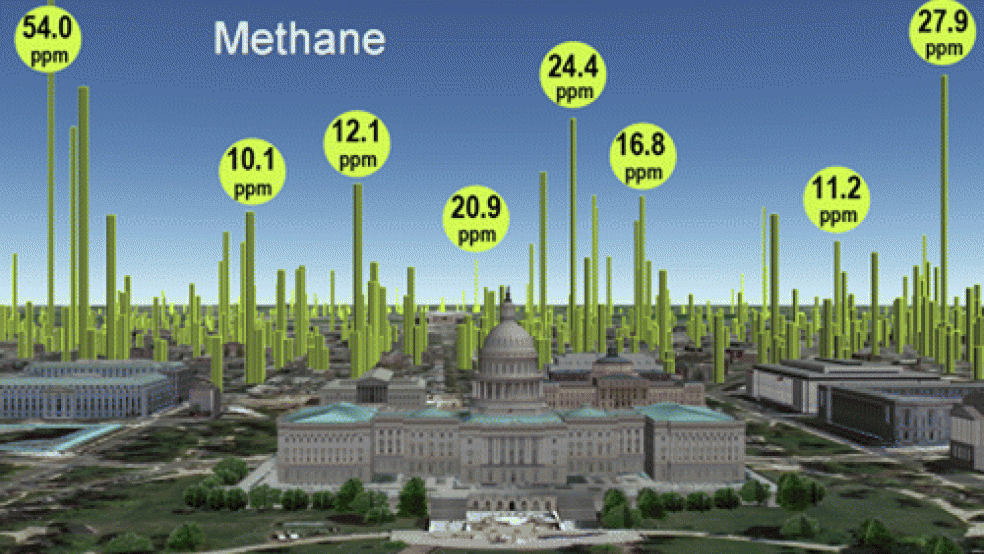Almost three months to the day that a southern California utility work crew finally capped a massive, runaway natural gas leak that allowed more than two million tons of methane gas to escape into the atmosphere above the San Fernando Valley, the Obama administration on Thursday issued final rules designed to prevent future environmental calamities of that sort from happening.
The United States and Canada agreed in March to take joint action to reduce methane emissions after nearly a year of planning, and yesterday the administration finalized the new rules.
Related: The California Gas Leak Ends, but It’s a Rough Week for Environmentalists
“We are really getting at a strong contributor to climate change…at a source of toxic emissions that affect public health” Gina McCarthy, the administrator of the Environmental Protection Agency (EPA), told reporters in releasing the regulations.
The nightmare blowout of a major Aliso Canyon natural gas storage facility in late October 2015 paralyzed a suburban Los Angeles community for months, displaced thousands of families, and closed two schools. It was deemed one of the worst environmental disasters since the 2010 BP oil spill along the Gulf Coast. The accident also taught many Americans an important environmental lesson: Methane, the primary component of natural gas, is 25 times more harmful to the atmosphere than carbon dioxide and is a major contributor to the mounting global warming crisis. Methane leakage accounts for about 10 percent of the annual greenhouse gas emissions in the United States, which in recent years has become the largest natural gas producer in the world.
Methane gas comes from a number of sources, including animal waste, particularly cattle and dairy cows, landfills, wastewater treatment and certain other industrial activities. However, a Greenhouse Gas Inventory Report issued last month by the EPA identified the oil and gas industry as the leading emitter of methane gas pollution in this country. The study estimated that industrial methane gas emissions through faulty equipment or accidents was 34 percent higher than previously assumed, and that more than 9.8 million metric tons escaped into the atmosphere every year.
Related: Did a Bad Decision 40 Years Ago Lead to the California Gas Leak Disaster
The rules announced yesterday by the EPA are tougher than regulations previously discussed and are designed to reduce methane emissions from the oil and gas industry by 40 percent to 45 percent of 2012 levels by 2025.
The regulations will require companies to achieve this goal by capturing gas from oil wells and finding and plugging leaks. Gas leaks are a common phenomenon within the oil and gas industry. Moreover, virtually every community in the country has struggled to repair or contain leaks from aging pipelines and underground storage tanks.
A report in the Guardian says the new rules will require companies “to put more efforts in detecting and repairing leaks in oil and gas wells, pipeline and other infrastructure – with quarterly inspection reports.” Companies will also have to conduct such inspections at low-producing sites – a requirement that apparently was added at the last minute.
Michael Brune, executive director of the Sierra Club, hailed the new rules as an important first step in combating the dangerous heat-trapping effects of methane gas leaks. “In taking this important first step, the EPA and the Obama Administration are rejecting the status quo that has allowed the oil and gas industry to recklessly pollute communities around the country for so long.”
Rep. Chris Van Hollen (D-Md), the co-chair of the Bicameral Task Force on Climate Change, said that “These simple and cost-effective actions will curb emissions of methane and other toxic pollutants from new and modified oil and gas wells.”
Related: Why the Gas Leak in California No One Is Talking About Is Such a Disaster
But an obvious shortcoming in the regulations is that they don’t apply to existing oil and gas wells unless they undergo an updating or modification. What’s more, McCarthy indicated it was now unlikely the administration would have time to try to impose the new rules on the one million existing oil and gas wells and other facilities before Obama leaves office in January.
The Obama administration’s companion effort to sharply reduce carbon dioxide emissions from existing coal-fired power plants has been challenged by state officials and appears to be indefinitely caught up in federal court proceedings.
The American Petroleum Institute, the main advocacy group for the oil and gas industry, argued that companies were already plugging leaks in pipelines and that the new methane gas rules were unnecessary. “Imposing a one-size-fits-all scheme on the industry could actually stifle innovation and discourage investment,” the organization said in a statement.





